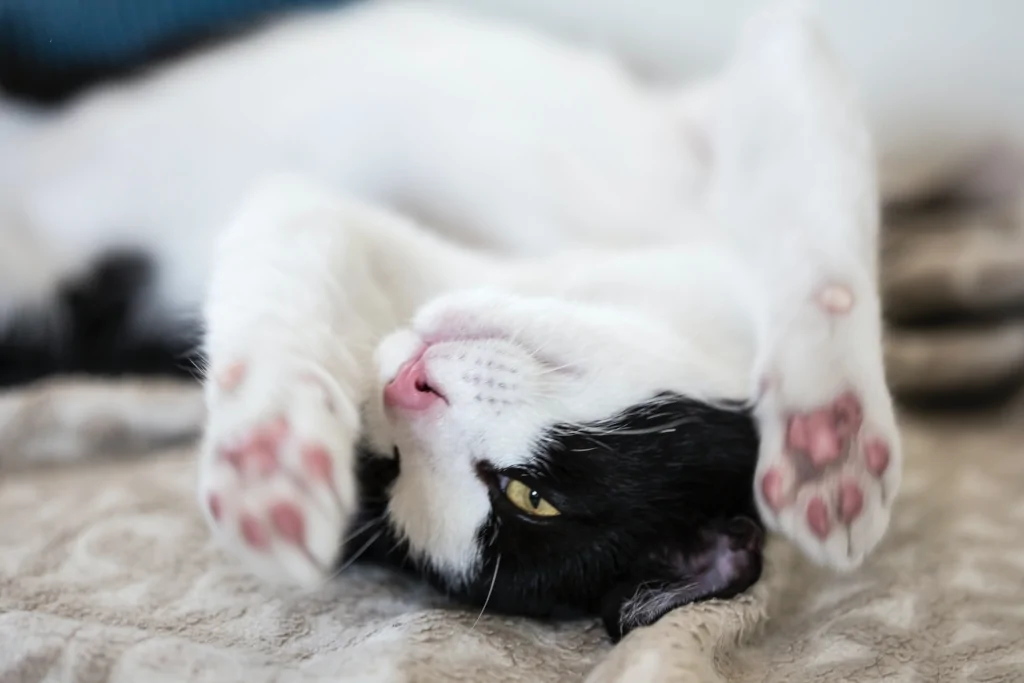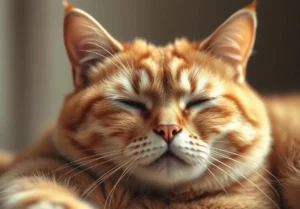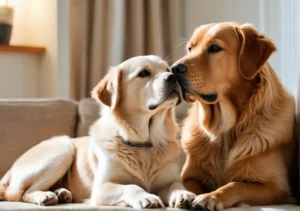Disclosure: We may earn a commission from helpful, relevant links in our content. No cost to you. See our privacy policy.
Have you ever watched your cat flick their paws and wondered what’s going through their feline mind? It’s a quirky behavior that leaves many cat owners scratching their heads.
In this article, we’ll explore the various reasons behind paw flicking and help you understand your furry friend’s unique language.

What’s the Deal With Paw Flicking?
Paw flicking is a natural behavior for cats that serves several purposes.
Cats may flick their paws to remove dirt, debris, or litter after using the bathroom, as a playful gesture during playtime, or as a means of non-verbal communication.
While this behavior is often harmless, it’s essential to pay attention to your cat’s overall body language for a more accurate understanding of their intentions.
Decoding Feline Communication
Cats are masters of subtle communication, and paw flicking is just one way they express their emotions or send a message.
To fully decode feline communication, we need to consider other body language cues such as ear positioning, tail movement, and vocalizations.
For instance, when my cat Smokey flicks his paw in conjunction with a swishing tail and flattened ears, I know he’s feeling annoyed or overstimulated. On the other hand, if he flicks his paw while his ears are perked up while making chirping noises, he’s likely engaged in a playful mood.
Recognizing these subtle differences in body language can help you better understand your cat’s needs and emotions, ultimately enhancing your bond with your feline companion.
Grooming Habits and Paw Flicking
Cats are fastidious groomers, and paw flicking can be a part of their grooming routine.
When cleaning their paws, cats may use their tongue to wet their paw before using it to clean their face and head. Afterward, they might flick their paw to remove excess moisture or lingering debris.
To support your cat’s grooming habits, provide a clean environment, and brush them regularly to prevent matting and hairballs.
If you notice excessive paw flicking during grooming, it could indicate an issue such as irritated skin or an injury, so be sure to check their paws and consult a veterinarian if needed. If your cat is injured, follow our guide to injury and pain management in cats.
In addition, we have a full, easy-to-follow guide on cat grooming here, which you should check out. Some great tips in there regarding keeping your cat healthy, including nail trimming.
When Playtime Leads to Flicking Paws
Paw flicking can be an expression of excitement or engagement during playtime.
Cats may flick their paws while chasing a toy or stalking an imaginary prey, mimicking the behavior of a wild feline capturing their target.
To encourage healthy playtime habits, offer a variety of stimulating toys and rotate them regularly to keep your cat interested.
Remember that interactive play sessions can strengthen your bond with your cat, so don’t hesitate to join in the fun! When playing with your cat, pay attention to their body language, and end the session if they become overstimulated or aggressive to avoid any injuries.
Is Paw Flicking Ever a Concern?
While paw flicking is often a normal part of a cat’s behavior, it can sometimes indicate a concern.
If you observe excessive paw flicking, sudden changes in frequency, or signs of distress, it’s essential to check for injuries, irritations, or foreign objects in their paws.
To help prevent potential issues, make a habit of regularly inspecting your cat’s paws for any signs of injury or irritation and keep their living environment clean and safe.
If the issue persists or worsens, consult your veterinarian for a thorough examination and appropriate treatment.
FAQs
Is paw flicking a sign of aggression?
Paw flicking can be a sign of excitement, playfulness, or grooming, but it is not typically a sign of aggression in cats. However, it’s essential to observe the context and other body language cues to understand your cat’s intentions.
Can I stop my cat from flicking their paws?
It’s usually unnecessary to stop a cat from flicking their paws, as it’s a natural behavior. However, if it seems excessive or bothersome, try redirecting your cat’s attention with toys or playtime to reduce the frequency.
Are certain cat breeds more prone to paw flicking?
Paw flicking is a common behavior across all cat breeds. While some individual cats may display this behavior more frequently, there is no specific breed predisposition to paw flicking.
Does paw flicking indicate a health issue?
Paw flicking can occasionally indicate a health issue, such as skin irritation, an injury, or a foreign object in the paw. If you notice excessive or sudden changes in paw flicking, accompanied by distress, it’s important to consult a veterinarian.
Alex, a passionate animal lover, has experience in training and understanding animal behavior. As a proud pet parent to two dogs and three cats, he founded AnimalReport.net to share insights from animal experts and expand his knowledge of the animal kingdom.




